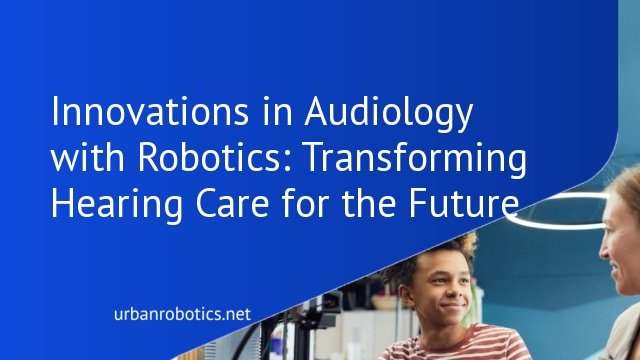Overview of Audiology Innovations
Audiology, an evolving field, has seen significant advancements due to robotics. Automated hearing tests now provide precise and rapid assessments. For instance, computer-aided audiometry can detect hearing loss with high accuracy. These robotic tools enhance audiologists’ ability to diagnose and treat patients effectively.
Robotic technology also revolutionizes cochlear implant procedures. Robotic-assisted systems ensure precision during implant placement, reducing surgical errors. This advancement improves outcomes and recovery times for patients, marking a leap in auditory healthcare.
Hearing aid technology benefits from robotic innovation too. Advanced fitting algorithms allow devices to be custom-tailored to individual hearing profiles. For example, Real-Ear Measurement (REM) ensures hearing aids are fine-tuned to the user’s specific auditory needs, contributing to better user satisfaction.
Robotics in audiology also aids in ongoing monitoring and maintenance. Autonomous systems can continuously evaluate device performance and patient hearing, enabling timely adjustments. This proactive approach ensures optimal hearing health and device functionality over time.
We observe that these innovations collectively set new benchmarks in audiological care. They represent a transformative shift, enhancing diagnostic precision, treatment efficacy, and overall patient experience.
The Role of Robotics in Audiology
Robotics is revolutionizing audiology by introducing precise diagnostic tools and advanced treatment options. These innovations are enhancing our capabilities and significantly improving patient outcomes.
Historical Developments
Early developments in audiology robotics began with simple mechanized tools used for hearing tests. The 1980s saw the introduction of programmable hearing aids, allowing for better customization. By the 1990s, robotic systems were assisting in delicate ear surgeries, increasing accuracy and reducing recovery time. These gradual advancements paved the way for today’s more complex robotic applications in audiology.
Current Technological Trends
Modern audiology leverages robotics for automated hearing tests, which provide accurate and quick results. Robotic-assisted cochlear implant surgeries offer higher precision and safer procedures. Advanced fitting algorithms, such as Real-Ear Measurement (REM), are now commonly used for customizing hearing aids. Additionally, autonomous systems monitor hearing aid performance and device functionality, ensuring optimal long-term hearing health.
Key Innovations in Audiology Robotics
Innovations in audiology robotics have redefined patient care and treatment efficiencies, with significant advancements enhancing hearing health.
Robotic Hearing Aids
Robotic hearing aids incorporate advanced algorithms and artificial intelligence. These devices self-adjust in real-time to ambient noise levels and user preferences. Examples include Oticon’s Opn S and Widex’s Evoke. They offer improved sound clarity and seamless experience across varied environments. Enhanced features provide personalized hearing experiences, ensuring optimal performance.
AI-Powered Cochlear Implants
AI-powered cochlear implants leverage machine learning and adaptive algorithms. These implants, like Cochlear’s Nucleus 7 Sound Processor, continuously learn from user environments. They offer superior sound processing, enhancing speech recognition. Real-time adjustments to sound levels provide users with a more natural hearing experience. Integration with mobile apps allows remote control and fine-tuning.
Automated Auditory Testing
Automated auditory testing utilizes robotics for precise and consistent hearing assessments. Devices like Otocube and HearX Group’s KUDUwave deliver reliable results without the need for clinician intervention. These systems streamline diagnostic processes, reducing wait times and increasing accessibility. Built-in data analytics optimize patient care plans based on test results.
Benefits and Challenges
The use of robotics in audiology offers significant advantages but also presents various challenges.
Enhanced Patient Outcomes
Robotics significantly improve patient outcomes. Quality and precision of robotic-assisted procedures like cochlear implant surgeries lead to better hearing capabilities. Automated hearing tests deliver consistent, accurate diagnostics, reducing human error. Real-Ear Measurement (REM) fitting algorithms provide customized hearing aids, ensuring optimal performance and comfort. AI-powered cochlear implants adapt to different auditory environments, enhancing user experience.
Technical and Ethical Considerations
Implementing robotics in audiology involves technical and ethical challenges. High initial costs and ongoing maintenance might limit access to these advanced technologies. Professionals require specialized training to operate complex robotic systems effectively. Ethical concerns include patient data privacy and the potential depersonalization of care. Ensuring equitable access and maintaining human-centric care remain critical in the adoption of these innovations.
Future Prospects
Innovations in audiology with robotics continue to evolve, promising significant advancements. Emerging technologies and their potential impact on healthcare highlight the exciting possibilities.
Emerging Technologies
Machine learning, neural networks, and advanced sensory devices are emerging as key technologies. AI-driven hearing aids adapt to the user’s environment for optimal sound quality. 3D printing enables precise customization of hearing devices, ensuring a perfect fit. Tactile feedback systems, like haptic feedback gloves, assist audiologists in their diagnostics process. These technologies enhance auditory rehabilitation, making them indispensable in modern audiology.
Potential Impact on Healthcare
Robotic innovations can transform audiology, increasing accessibility and efficiency in healthcare. Automated systems like tele-audiology provide timely diagnostics, especially in remote areas. Enhanced hearing devices improve quality of life, facilitating better communication. Robotics aids in complex surgeries, reducing recovery time and improving outcomes. These advances streamline audiology services, positively affecting both patients and healthcare providers.
Conclusion
Robotics in audiology is revolutionizing our approach to hearing healthcare. These technologies are not just about innovation; they’re about making a tangible difference in patients’ lives. As we navigate the challenges, it’s essential to focus on ethical considerations and equitable access. By leveraging advancements like machine learning and 3D printing, we can create more personalized and effective hearing solutions. The future of audiology promises enhanced patient care and streamlined services, ensuring that everyone benefits from these groundbreaking developments.





